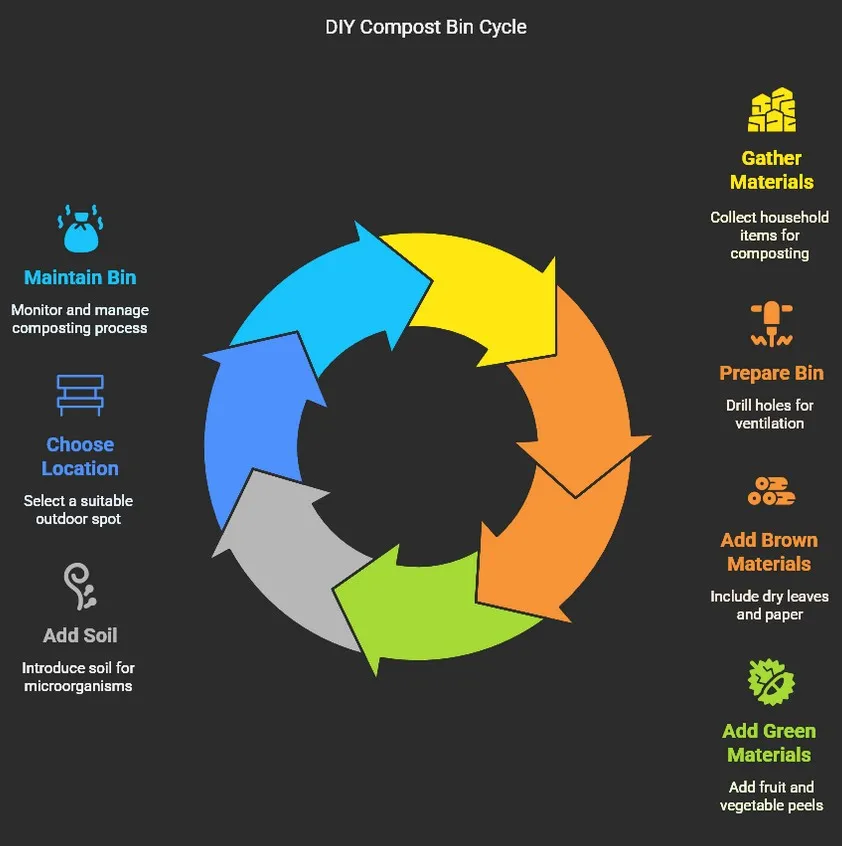Nowadays, the need to save the environment and reduce household waste has increased more than ever. Vegetable peels, fruit pieces, and dry leaves from the garden are often thrown in the trash. A DIY compost bin made at home can make this task easy and fun. This will not only reduce waste, but will also produce excellent and free fertilizer for your plants. This method is not only economical but will also make you feel more connected to nature.
In this article, we will tell you how you can easily make a compost bin at home. We will explain each step in such a simple way that anyone can follow it. Whether you have a small garden or just a few pots, this compost will make your plants green and healthy. Also, it will be a small contribution from you to the environment. So without delay, let’s know what is the right way to make a compost bin at home.
What is a DIY compost bin, and why is it important?
A compost bin is a container where organic waste is put to make compost. Organic waste includes wet kitchen waste, such as vegetable peels, tea leaves and dry garden waste, such as dry leaves and twigs. When these things slowly rot, they turn into nutrient-rich compost. This is a natural process in which microorganisms help.
In today’s time, reducing waste has become very important. Every day, millions of tons of waste are generated all over the world, most of which goes to landfills. If we start using compost bins at home, this amount of waste can be reduced to a great extent. According to environmental scientists, about 50-60% of household waste is organic, which can be reused by making compost. This also improves the health of the soil and reduces the need for chemical fertilizers.

Materials required to make a DIY compost bin
Making a DIY compost bin does not require much expense. You can make it using things already present in your house. First, take an old plastic box or bucket that has a lid. Apart from this, you need a drill machine or any sharp object to make holes for air. Apart from this, collect dry leaves, twigs, and pieces of paper, which will act as “brown material” in the compost. Wet waste, such as peels of fruits and vegetables, is called “green material”. Also, keep some soil, as the microorganisms present in it help in the process of composting.
After collecting the material, you also have to choose the right place to keep it. Keep it in a shady and airy place outside the house. Try to protect it from strong sunlight and rain. If you do not have a garden, then a balcony or terrace will also be fine. Just keep in mind that if compost is not made properly, it can smell, so do not keep it inside the house.

Easy process of making a bin
Now it is time to prepare the DIY compost bin. First, make small holes all around and at the bottom of the bin. These holes are necessary for the passage of air so that the waste turns into compost slowly instead of rotting. After this, first spread a thick layer of dry leaves or paper inside the bin. This will help in absorbing moisture.
Now you can put the wet waste from your kitchen in it. Every time you add wet waste, put some dry waste on top of it, so that the balance of moisture and air is maintained. Also, add some soil every few days, so that the process of composting is accelerated. Shake the bin every 3-4 days or stir it with a wooden stick, so that the air reaches inside properly. If it feels dry, you can sprinkle light water, but avoid too much moisture. Your compost will be ready in about 6-8 weeks.

Benefits of a Compost Bin
The biggest advantage of making a DIY compost bin at home is that it reduces waste. When you convert kitchen waste into compost instead of throwing it out, the amount of waste going to landfills decreases. Another advantage is that you get free natural fertilizer, which is very beneficial for your plants. It contains nutrients like nitrogen, phosphorus, and potassium, which improve the quality of the soil.
Apart from this, a compost bin also helps in keeping the environment clean. Less waste means less pollution. If composting starts in every house, then a big difference can be seen. This is also a great way to make children aware of nature. They will see that something useful can be made from waste.

Precautions and Tips
It is important to keep some things in mind while making a compost bin. Do not put meat, fish, eggs, or dairy products (milk-curd) in it, as they can smell and attract insects. Do not put things like plastic, glass, or metal in it either, as they do not rot. If the compost starts smelling bad, then add more dry waste to it and stir it. Take special care of moisture in summer, so that the compost does not dry up.
Another good tip is that you can add neem leaves to it. It keeps pests away and improves the quality of the compost. Be patient, as compost takes some time to form. When it is completely ready, it will be dark brown in colour and smell like earth. Add it to your plants and see the difference.
Making a DIY compost bin at home is easy, cheap, and beneficial. Yes, it does take some time to prepare, but it is a great way to reduce your waste and keep your garden green. It just takes a little effort and patience to get started. If you have a vertical garden or potted plants in your home, then definitely do composting. This is a small but effective step to save the environment.






